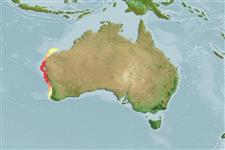分類 / Names
俗名 | 同種異名 | Catalog of Fishes(屬, 種) | ITIS | CoL | WoRMS | Cloffa
Teleostei >
Aulopiformes (Grinners)
仙女魚目 (Grinners) >
Pseudotrichonotidae (Sand diving lizardfishes)
擬鱚科 (Sand diving lizardfishes)
Etymology: Pseudotrichonotus: Greek, pseudes = false + Greek, thrix, -ichos = hair + Greek,noton = back (Ref. 45335); belos: Name from Greek meaning arrow or dart, referring to the dart-like appearance of the species; noun in apposition.
Environment: milieu / climate zone / depth range / distribution range
生態學
海洋 居於水底的; 深度上下限 100 - 120 m (Ref. 117888).
分布
國家 | FAO區域 | 生態系 | 發現紀錄 | Point map | 簡介 | Faunafri
Eastern Indian Ocean, Western Australia.
大小 / 重量 / 年齡
Maturity: Lm ? range ? - ? cm
Max length : 4.1 cm SL 雄魚/尚未辨別雌雄; (Ref. 117888)
簡短描述
檢索表 | 型態特徵 | 形態測量圖
背的軟條 (總數) : 31 - 33; 臀鰭軟條: 12; 脊椎骨: 48 - 50. This species is distinguished from its congeners by the following characters: Dorsal-fin origin is well behind the pelvic fin origin, predorsal length 39.6-41.2% SL; D 31-33; A 12 (Ref. 117888).
This species was collected from 100 m on sand, possibly from finer shell hash deposits. This collection also yielded high diversity of other organisms, including a large amount of sponges, as well as rubble while the second area of collection included gorgonians and shell hash (Ref.117888)
Life cycle and mating behavior
成熟度 | 繁殖 | 產卵場 | 卵 | 孕卵數 | 仔魚
Gill, A.C. and J.J. Pogonoski, 2016. Pseudotrichonotus belos new species, first record of the fish family Pseudotrichonotidae from the Australia (Teleostei: Aulopiformes). Zootaxa 4205(2):189-193. (Ref. 117888)
IUCN 瀕危狀態 (Ref. 130435: Version 2024-2)
人類使用
工具
特別的報告
下載 XML
網路資源
Estimates based on models
Phylogenetic diversity index (Ref.
82804): PD
50 = 0.6250 [Uniqueness, from 0.5 = low to 2.0 = high].
Bayesian length-weight: a=0.00389 (0.00180 - 0.00842), b=3.12 (2.94 - 3.30), in cm total length, based on all LWR estimates for this body shape (Ref.
93245).
營養階層 (Ref.
69278): 3.4 ±0.6 se; based on size and trophs of closest relatives
Fishing Vulnerability (Ref.
59153): Low vulnerability (10 of 100).
